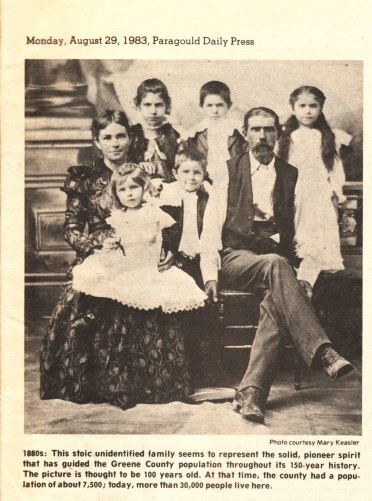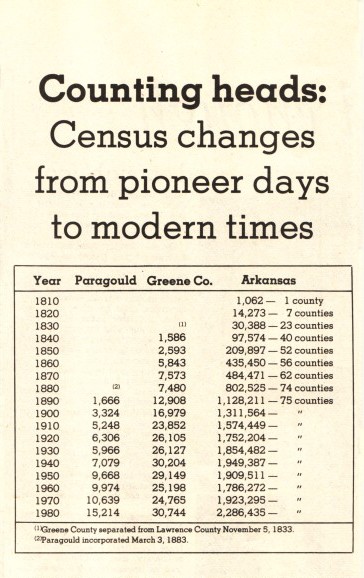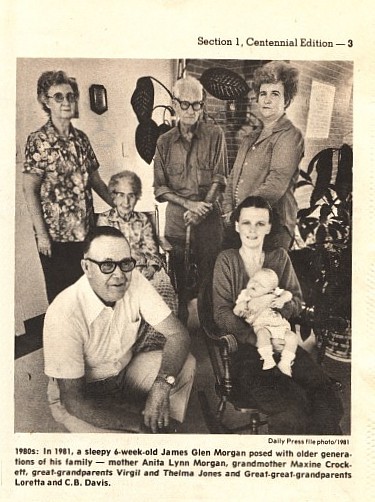


Greene County Arkansas
Paragould, Arkansas
Centennial Edition Section 1
Paragould Daily Press, Monday, August 29, 1983 Section 1, Centennial Edition --3
=============================================================================================================
 |
 |
 |
| In 1893, only 10 years after its
incor- poration, Paragould had a population of 2,544 -- a special census had been conducted that year to prove the town had achieved the population needed to rank as a second-class city. Fourteen years later, in 1907, when the city conducted another special census to gain first-class status, its population had doubled to 5,122. Paragould recorded substantial growth during those early years, as its location on two railroads in the midst of rich timber and newly- cleared farm land created a boom economy that has not been repeated since. Later population growth was to be gradual, caused less by immigration and more by natural increase and an- nexation. And there would also be population decline and stagnation until the city and its county could es- tablish a diversified agriculture-indus- trial economic base. The earliest known Paragould cen- sus is that of 1887, only four years after the town's incorporation, when the population was counted at 1,364. In 1890, Paragould participated in its first official federal census. In 1889 when the Goodspeed Publishing Co. of Chicago printed its Biographical and Historical Memoirs of Northeast Arkansas, which included chapters on Greene and 11 other counties, the compiler noted, "The town has grown rapidly, and in the seven years of its existence has attained a population of about 2,000." That estimate, like others that would follow, proved to be optimistic when the official 1890 total was tallied. |
In the 1909
Soliphone special issue found elsewhere in this special edition, the editor estimated Paragould's popu- lation to be about 6,000. "It may be a few hundred less or it may be a few hundred more, but people who claim seven or eight thousand are either ignorant of what the population is or else purposely exaggerate..... The federal census to be taken next year will not likely show the population to much in excess of 6,000 if any," he wrote. It was a good thing he added that final qualifier, for the 1910 official census fell several hundred short of his estimate. Paragould Up-to-date, a 1918 Chamber of Commerce-type publica- tion, estimated the city's population at about 8,000. A 1928 industrial pro-motion brochure sponsored by the St. Louis Southwestern Railway included a 10,000 estimate. In 1957, the Chamber of Commerce estimated the city's pop- ulation to be 11,000. As a quick check of the corresponding official census fig-ures shows, these estimates proved to be inflated. Goodspeed's also estimated that the population of Greene County had doubled. That estimate was a couple of thousand off, but between1880 and 1890 the county's population did jump dramatically. Paragould's first official census showed that the new county seat con- tained about 13 percent of the county's population. That percentage of popula- tion would grow steadily until the most recent federal census, 1980,shows that just under half of the county's full population -- 49.5 percent --reside in its largest city. Until the economic boom that coin- |
cided with Paragould's early years, there was no town in the county that had more than 1,000 residents.Gaines- ville's population in 1880 has been estimated at less than 300 and it was then the county seat and largest town. that says as much about the times as about the towns. In the 1840 federal census, Greene County's first, the whole county (which then included a good portion of what is now Clay County) included only 1,586 residents. During its first 100 years, the county experienced steady growth. The creation of Clay County in 1873 explains the drop in Greene County's population in the 1880 census. (The procreation of Arkansas coun- ties makes the study of early census figues tricky. Lawrence County, known as the "Mother of Counties" because about 30 other subdivisions were carved from its original area, had an 1820 population of 5,582. Several new counties were created from Lawrence in the intervening years, leaving it with an 1830 popu- lation of 2,806. After Greene and even more counties were carved off, Lawrence had an 1840 population of 2,835.) The population of both Greene County and Paragould continued to rise gradually until the 1920s. Para-gould suffered its first, and so far only, population loss in the 1930 census. In that same census the official county total increased by only 22 persons. Those were the Depression years and the economy was undoubtedly a prime factor in the stagnation. But the hard-times of later years |
would also chip away at the county's population and it is only now regain- ing what it lost. Between 1940 and 1980, Greene County registered a gain of only 540 persons. The post-World War II years had seen a devastating decline in the county's population as it dipped almost to 1910 levels. The changing economics of agriculture meant fewer workers were needed in the fields, but the industrial base hadn't kept pace and there were few jobs for the displaced workers. Many left for points North and West in search of work. Paragould, while it has experienced only one decennial population loss, did not register any significant population gains until 1980 and that was based partly on its merger with Center Hill and several other property annexa- tions. Between 1950 and 1960, for in- stance, the city gained only about 300 residents. Researcher's Note: Because of conflicting data and the chance of typo-graphical errors, census figures are sometimes hard to pin down. For instance, Vivian Hansbrough's History of Greene County cited a special 1893 census of 2,528 while the records filed with the secretary of state's office in- cluded the 2,544 figure. Goodspeed's listed slightly different county census totals for the early county years than did another historical source. Other discrepancies were also found, so the charted figures sometimes involved a judgment on the reliability of the source Even today the federal government releases so many preliminary and final census versions that it's hard to keep the numbers straight. |
Transcribed from the 1983 Centennial Edition by : PR Massey
Return to Greene County, Arkansas Centennial Edition
Return to Greene County, Arkansas Newspapers
Return to Greene County, Arkansas Index Page
© 2010 PR Massey